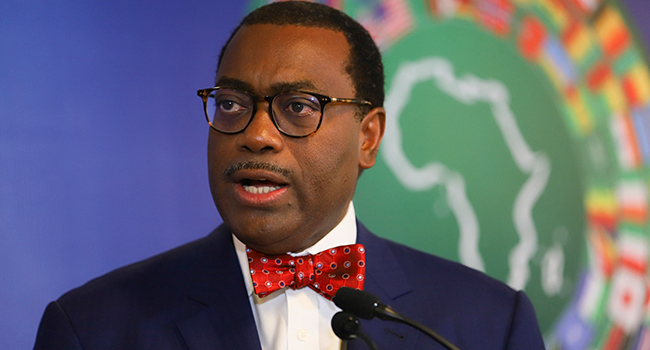The President of the African Development Bank (AfDB) Group, Dr. Akinwumi Adesina, has charged African leaders to reverse the ugly trend of greedy exploitation of the continent’s green environmental assets by foreign countries and focus on the huge natural capital endowments and utilize them for the sustainable growth of their economies.
The development finance expert gave this charge in his address delivered at the 29th Conference of the Parties (COP 29) with the theme “Measuring the Green Wealth of Nations: Natural Capital and Economic Productivity in Africa” held in Baku, Azerbaijan.
Adesina pointed out that Africa had some of the largest sources of natural capital in the world, including over 40% of the world’s clean energy potential; 65% of the world’s uncultivated arable land; 25% of global biodiversity; and 20% of the world’s tropical rainforest area.
This is even as he explained that the Congo Basin remained the second largest carbon lung in the world after the Amazon forest, stretching 314 million hectares with 1.2 million kilometers of primary forest.
According to him, the peatlands of the Congo Basin store 29 billion tons of carbon, equivalent to 3 years’ worth of global greenhouse gas emissions just as the Congo basin also absorbs about 1.5 billion tons of carbon dioxide per year, and Africa’s forests account for 26% of all carbon sequestration in forests worldwide.
The AfDB President also noted that African continent also held considerable non-renewable natural resources, accounting for 50% of the world’s reserves of cobalt (used for batteries), 40% of manganese reserves (used in solar and wind farms) and more than 80% of platinum reserves, complemented by rich endowments of nickel, copper, and rare earth minerals.
Adesina maintained that these natural resources remained crucial for global green energy transition with electric vehicles and battery energy storages systems, whose estimated value is expected to rise from $7.5 trillion to $59 trillion.
He further clarified: “Africa is also endowed with abundant renewable energy: an almost unlimited potential of solar capacity (10 TW), hydro (350 GW), wind (110 GW), and geothermal energy sources (15 GW), all of which are the backbone of a less carbon-intensive and more sustainable energy system.
“Therefore, while Africa contributes significantly to global public good for tackling climate change with its vast resources of natural capital, its vast natural capital has been undervalued. This vast natural capital is not taken into consideration in valuing the GDP of African countries. For example, while the GDP of Africa was estimated at $2.5 trillion in 2018, this was 2.5 times lower than the estimated value of its natural capital, evaluated at $6.2 trillion, which partly includes some valuation of the ecosystem services.
“This situation makes Africa to be “green endowed” but “cash poor”, he lamented.
The foremost banker expressed optimism that when the value of Africa’s vast forest and environmental services, and natural capital, are properly valued, the size of its rebased GDP taking this into account will be much higher.
He disclosed that the AfDB’s preliminary estimates, based on very conservative assumptions, showed that Africa’s nominal GDP in 2022 could have increased by $66.1 billion when adjusted for carbon sequestration only, adding that is more than the combined GDP of 42 African countries!
Adesina further pointed out that the proper valuation of Africa’s green GDP remained where the trillions of dollars for the continent, based on proper valuation, will come from, to boost the wealth and financing of the continent, stressing that the greening of the GDP will also have other benefits, including the development of carbon markets in Africa.
Unfortunately, he lamented that today several African countries were giving away their vast amounts of land to carbon credits, noting that while this may generate some short-term financing, it needs to be understood that Africa is a carbon price taker and therefore is short-changed.
He expatiated: “While the price of carbon in Europe is high and could be as high as $200 per ton because of the strict EU Emission Trading Standards, carbon price in Africa could be as low as $3 to $10 per ton.
“The widespread sales of vast areas of Africa’s lands rich in carbon, what I call “carbon grab”, has five consequences, which we must understand, namely First, the countries are being underpaid for the carbon, due to the undervaluation of Africa’s carbon sinks; Second, the sequestered carbon on the lands can no longer be used as part of the nation’s nationally determined contributions; Third, the countries lose sovereignty over their lands; Fourth, the carbon sequestered over these lands and forests cannot be used to rebase and revalue the green GDP of the countries; and Fifth, the ongoing carbon grab in Africa is a lose-lose proposition.
Adesina maintained that the proper valuation of Africa’s green wealth would increase access to financial flows, in part because credit ratings agencies will be able to incorporate the true value of overall asset class, which in turn could improve countries’ risk profile.
To translate the huge endowments to real gains for the continent, he canvassed: “Therefore, it is time for Africa’s green environmental assets to be properly priced to allow the continent to turn its massive green assets into wealth, through their inclusion in “green’ GDP for Africa. This will raise massive financial resources for the continent, spur greater green investments and provide better policies for the greening of African economies for sustainable development.
“The significantly higher revenues that Africa will generate from the proper valuation of its carbon sinks and environmental services will also allow it to be able to service its debts, assuring debt sustainability”, the AfDB President added.






